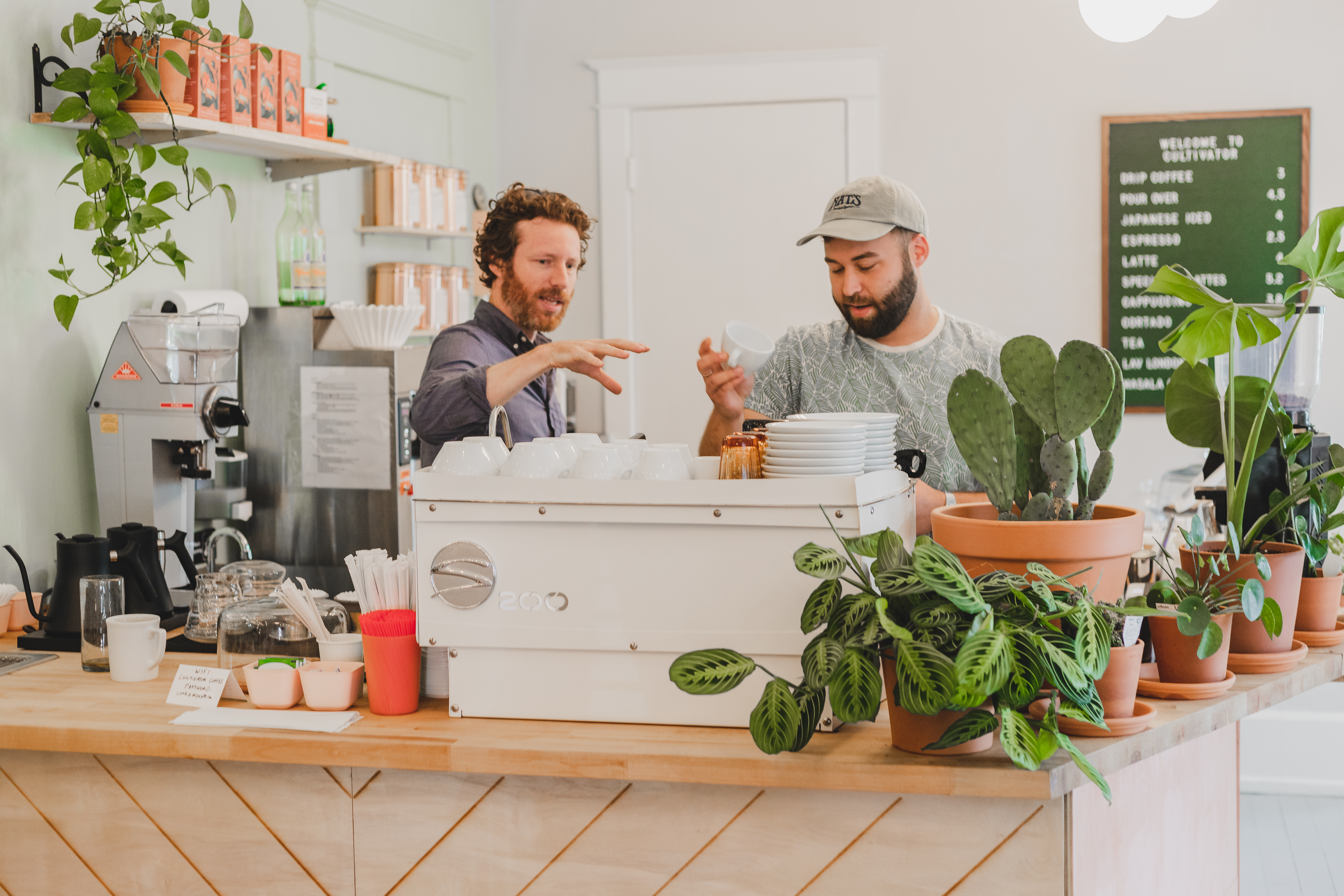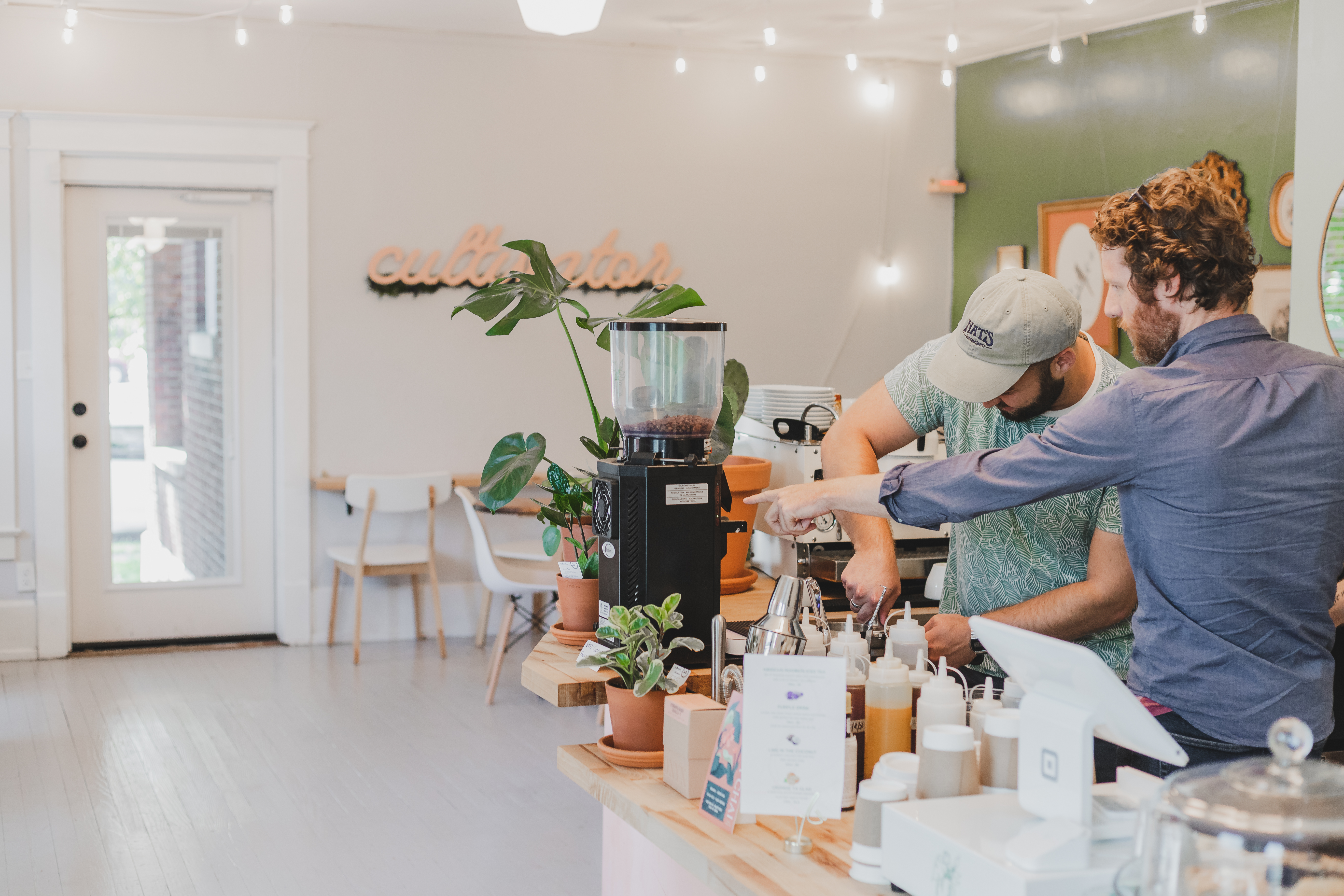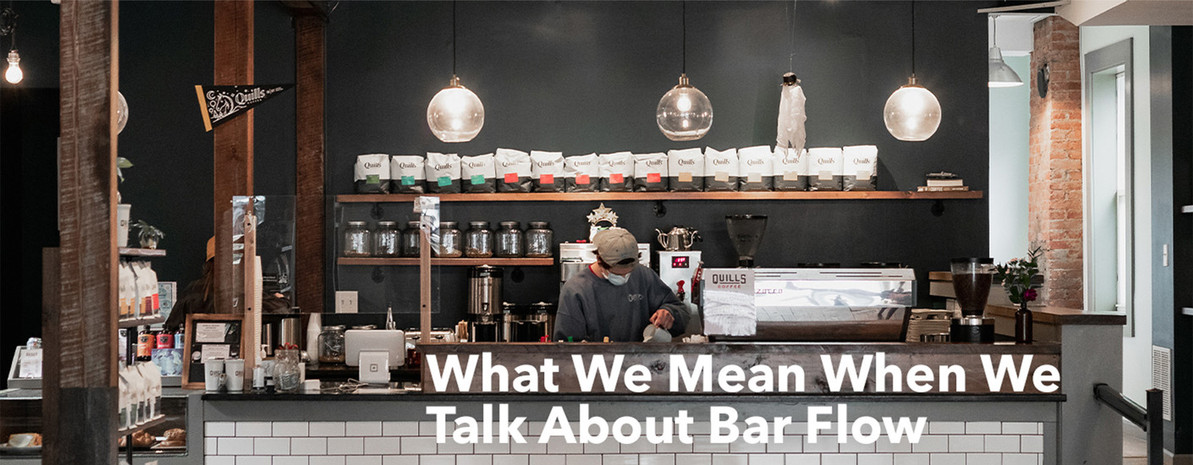What We Mean When We Talk About Bar Flow
The phrase “bar flow” gets thrown around a lot in coffee circles, but what does it really mean? What do we mean when we say “bar flow”? The simple answer is the obvious one: the flow (movement) of bodies (employees) behind the bar. The goal is to get bodies from A to B along the most efficient, least congested path. The margins on coffee are low—too low, really, for the costs along the supply chain—so the truest way to solvency is volume.
In a coffee shop, this has two major implications (and a bunch of minor ones). At the espresso station, the baristas must be able to move from refrigerator (or speed rail) to grinder to espresso machine to knock-box and back again—sounds like a lot, right?—with very few foot movements and without getting in the way of other employees, passing or stationary. At the other major station, batch brewing, baristas must be able to move from filters to grinder to brewer to servers with similar swiftness and also without getting in the way. You can already see the space coming together—an espresso station and a batch brewing station, separated by some distance and ideally staffed by separate employees who, over the course of a shift, won’t get in each other’s way and have a direct path to designated drink service area (usually at a corner of the counter).
 On the other hand, you can already sense the complications involved in designing the bar for optimal flow. Move one piece, such as the espresso grinder, for instance, and it will affect all the other movements. We have all seen cafés with an espresso grinder or two on a back counter far from the espresso machine. This tends to happen if a café grows and wants to feature an additional espresso, likely a single origin, as an option. While this is a great addition to the menu, it is a product of poor planning from the beginning. Build a little bit of growth into the initial plan, and also save some room under the counters for storage, because as the business grows, products and supplies might grow, too.
On the other hand, you can already sense the complications involved in designing the bar for optimal flow. Move one piece, such as the espresso grinder, for instance, and it will affect all the other movements. We have all seen cafés with an espresso grinder or two on a back counter far from the espresso machine. This tends to happen if a café grows and wants to feature an additional espresso, likely a single origin, as an option. While this is a great addition to the menu, it is a product of poor planning from the beginning. Build a little bit of growth into the initial plan, and also save some room under the counters for storage, because as the business grows, products and supplies might grow, too.
Designing a coffee shop can be fun, but it is a challenge. A useful way to set up the bar is to think in terms of the two stations mentioned above. At the espresso station, the barista should be able to reach everything necessary for preparing espresso drinks (5-lb. coffee bags, espresso grinder, espresso machine, milk pitchers, milk, syrups, knock-box, tamper, cups, etc.). At the batch brewing station, the barista should be able to reach everything for preparing those drinks (grinder, filters, brewer, cups, sleeves, lids, etc.). In short, do the baristas have to walk across the bar to get any vital piece of the equation for any drink? If so, flow is lacking.
The more thoroughly you have thought these through before securing a location and completing the buildout, the more efficient the staff will be; and, as a result, the happier it will be. (Getting in the way, or feeling in the way, can be frustrating after all, and doing it all day can be stressful; and this stress gets passed on to the customers.) Planning a coffee shop is like planning a city, and—as Jane Jacobs, in her classic The Death and Life of Great American Cities, long ago showed—the residents (in this case baristas) won't necessarily follow the prescribed walkways. Instead, they'll find their own grooves. However, there does exist a way to design a space, including a coffee shop, with a kind of internal logic that will significantly reduce the amount of moving and/or thinking about movements the baristas will have to do and in turn make their work lives a little easier.
“In a slow café, a semi-automatic machine is perfectly
fine; in a busy café, though, a machine with programmable
shots (by volume or time, for instance) is essential.”
What is possible in flow is determined in part by the features of the equipment. Take the espresso machine, for example. On a semi-automatic espresso machine, the barista has to push a button to start the shot and push it again to stop it. This whole process takes only about 30 seconds, but still this is precious time that could be spent on another task, even if that task is talking to a customer or gathering milk and other ingredients for the drink. It is entirely possible to pour and steam milk and still keep an eye on the shot; but that is really the only double-tasking option and even this one isn’t second-nature for every barista. In a slow café, a semi-automatic machine is perfectly fine; in a busy café, though, a machine with programmable shots (by volume or time, for instance) is essential. Once a shot is programmed, baristas can move about the space without having to keep an eye on the time, shot glass, or scale. Freed of the task of watching, they can better serve the customers and each other.

Some recently released espresso machines, such as the Victoria Arduino Black Eagle and La Marzocco PB ABR are available in models with built-in scales that stop shots at a programmed weight, another option for the busy café. These can be paired with an extremely fast grinder like the Mahlkönig E80 Supreme or Mazzer Robur S, which both grind fluffy doses of espresso in about 3 seconds, and an automatic tamper like the Puqpress to make shots in under a minute. If choosing analog tamping instead, though, we recommend putting a tamping station with a rubber mat, precision tamper (like the Pullman BigStep), and distribution tools either in front of the espresso grinder or between the grinder and espresso machine, and placing the knock-box (or countersunk chute that guides grounds directly into a waste bin) in a logical position where the baristas will naturally pass, such as next to the grinder. This flow thing is all about the logical placement of equipment and accessories and, when financially feasible, speed. Waiting is not flow. Movement is.
As is probably obvious by now, when we talk about bar flow, we are talking about rhythm. The bar is a kind of living, breathing organism. As such, it works best when, as with hearts, we don’t have to attend to every little beat; it just works. Sit in a café and watch sometime. Are the baristas zig-zagging, doubling back, crossing each other’s paths, saying “sorry” often? Do they have to cross and re-cross the space to gather articles for individual tasks? If so, the flow is not quite established. Responsibilities might not be allocated clearly, either, which leaves everyone doing everything, an inefficient way to proceed in any endeavor, and also a maddening one for the people involved.
“As is probably obvious by now, when we talk
about bar flow, we are talking about rhythm.”
If you can afford to do so, put a barista at every station. If business is predictable, one barista can handle the register and batch brewing / coffee service, which includes cold brew (and filling cups with ice). If you can afford only one barista, place all the stations close to each other, including equipment like the ice machine, perhaps on either leg of an L-shaped counter, allowing the barista to make coffee when an espresso is being pulled, or to quickly reach the ice machine. Picture the barista's movements and design the bar from there. Don't forget that cold brew needs ice (and thus an ice machine), an espresso station needs milk (and thus an undercounter refrigerator or ice bin), a coffee brewer needs filters, and some customers are on the go (and thus require paper cups and sleeves). Every station needs everything it needs. Keep it all close. Allow the baristas to establish a rhythm.
Sit in a café with an efficient system in place and the difference is palpable. This isn’t the result of luck; instead, that well-oiled machine was planned, probably before the bar was built and very likely before the staff was hired. Flow is an important piece of the buildout puzzle and one that too often goes overlooked in the planning stages. It is our goal to make sure it never goes overlooked or undervalued. If you would like some in-depth help designing an exceptional bar, feel free to reach out to our commerical services team, and be sure to join the Prima Coffee Community Industry Pro Space for additional resources and join the conversation with other industry professionals.



